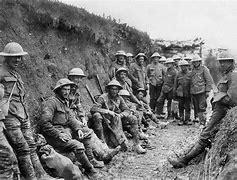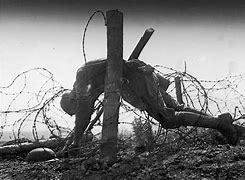WORLD WAR 1
THE WESTERN FRONT



World War 1 was one of the biggest wars that this world has ever seen, and it started in1914 and ended 1918. The reason the war started was because the Great Britain declared war on Germany due to its invasion on the neutral Belgium and the assassination of Franz Ferdinand by the South Slav nationalist Gavrilo Princip. It was a battle between the triple entente and the triple alliance. The triple entente consisted of France, Russia, and the Great Britain. The triple alliance included countries like Germany, Austria-Hungary, and Italy. Australia was always out there to help Great Britain, so we were part of the triple entente. The Australians got involved in the Gallipoli campaign, the Sinai and Palestine campaign, and the one I’m going to talk about the Western Front campaign. There was a lot of militarism prepared for this war as this was going to be the first world war and the biggest world war that they were going to ever face. The war of Gallipoli went on for 8 months from April all the way up to December.
 A picture of Franz Ferdinand who got assassinated.
A picture of Franz Ferdinand who got assassinated.
Somme trenches in France had lasted for 4 months from July up to November. The battle of Sinai and Palestine started in 1917 as that was when they entered Palestine. In 1918 they had then entered Jordan and Syria. The campaign was then ended on the 31st of October. There was a total of 416,800 Australians that had enlisted for WWI, and more than half of those soldiers were at the Western Front (295,000 soldiers). They most likely signed for the reason of good payment, being able to serve their country or to escape the life they had previously. The triple Entente had more power or imperialism in comparison to the Triple Alliance due to how many countries had join the Triple Entente and eventually powered through the Triple Alliance. Nationalism was a big thing in this war because some countries were a lot more or were believed to be more superior to the other. The Australians had believed that Great Britain was more superior so whenever they went into war the Australians always went into war with them as we will always help Great Britain no matter what the case is. This is also because Great Britain is our alliance and they always will be, unless a war happens between Australia and Britain, but I doubt that will happen.


The Battle of the Somme had started on the first of July in 1916 two years after WWI had started. The battle was in France on the river of the Somme hence the name the battle of the Somme. there were only five thousand Australians soldiers that fought in the battle of the Somme.
The experience of the Battle of the Somme was terrible as there were diseases and rat infestations and even a point where one of the soldiers were screaming so loud it had probably made most the soldiers go insane.

 A picture of the soldiers in The Western Front
A picture of a soldier stuck in the barbed wire. (not the photo of the soldier who was screaming)
A picture of the soldiers in The Western Front
A picture of a soldier stuck in the barbed wire. (not the photo of the soldier who was screaming)
some short term and long-term impacts of the war on the on the battlegrounds was that the Germans goal was to be able to do serious damage to the French Army. The mounting French casualties at Verdun so the British took charge of the plan and when to attack the Somme. Haig wanted to make a key breakthrough on the western front by mounting major offensive at the Somme.
One of the famous soldiers that had fought in the battle of the Somme was named Captain Francis Claude Lloyd. he was famous for his determination and endurance in the battle of the Somme.
 a photo of Sir (Captain) Francis Claude Lloyd
a photo of Sir (Captain) Francis Claude Lloyd
Somme was terrible as there were diseases and rat infestations and even a point where one of the soldiers were screaming so loud it had probably made most the soldiers go insane. At first it was fine as they had just gotten into the trenches, and they were adapting to it and getting used to it. It was fine until they had realised that most of their men were getting trench foot or what we now call today, athletes’ foot. They fixed this problem by putting wooden boards on the floor to prevent them from getting trench foot. This then led to another problem where mice were going around, and they had carried many diseases with them.
(Reference photo not actual photo from the Somme) soldiers covering their ears to block out the sound of the other soldier screams.

 a photo of some of the rats that were being killed in the trenches
a photo of some of the rats that were being killed in the trenches
They had ultimately tried to kill the mice themselves using anything they can other than their guns and ammo. Eventually after they had thought they dealt with everything all of them had then heard this loud ear-piercing scream coming from the front. They had realised one of their soldiers had fallen into the barbed wire. They tried to get him out of there, but two soldiers got shot and killed which led them to abandon that mission. His loud screaming went on for hours and everyone had tried to block their ears but out of guilt they could not get that scream out of their head. Eventually after hearing those screams for 3 days straight, it had eventually turned dead quiet.

 A picture of a soldier stuck in the barbed wire.
(not the photo of the soldier who was screaming)
A photo of the trench foot disease
A picture of a soldier stuck in the barbed wire.
(not the photo of the soldier who was screaming)
A photo of the trench foot disease
HAVE A LOOK BELOW FOR ANY KEY DATES AND INFORMATION REGARDING THIS ASSESSMENT
1914
THE YEAR OF 1914 IS WHEN WARLD WAR 1 HAD STARTED BETWEEN THE TRIPLE ALLIANCE AND THE TRIPLE ENTENTE ON 1916 NOVEMBER 18TH THE BATTLE OF THE SOMME WAS OFFICAILLY ENDED WITH THE TRIPLE WINNING THE BATTLE OF THE SOMME WHICH WAS ONE OF THE MOST BRUTAL WARS CAUSING THE MOST CASUALTIES..
1916
1916
DURING 1916 ON JULY 1ST THAT WAS WHEN THE BATTLE OF THE SOMME HAD STARTED BETWEEN THE TRIPLE ENTENTE AND THE TRIPLE ALLIANCE.
1917
IN SPRING OF 1917 THE GERMANS HAD RETREATED BACK TO THE ' HINDENBURG LINE" WHICH HAD BEEN A SHORT DEFENSIVE POSITION FOR THEM AS IT WAS A CONSEQUENCE OF TROOPS SHORTAGE.
References used for the making of this e-book
10 Things You May Not Know About the Battle of the Somme (history.com)
